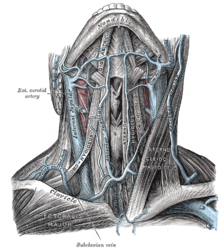Internal jugular vein

The internal jugular vein ("internal jugular vein ") is a vein in the neck. It runs behind the sternocleidomastoid muscle (head nodding muscle ) parallel to the common carotid artery (carotid artery) and the trachea . It begins as a continuation of the sigmoid sinus at the jugular foramen of the base of the skull and then runs deep into the neck, together with the carotid artery in the carotid vagina . It collects blood from the occipital and throat areas. In some species this vessel is not developed (e.g. sheep) or does not occur regularly in all individuals (e.g. horses ). The internal jugular vein joins the external jugular vein and the subclavian vein at the vein angle .
The internal jugular vein is neither directly visible nor palpable. That is why ultrasound is used to examine the vessel. As with the external jugular vein, the filling changes considerably depending on the position of the body. In the head-down position it is full and up to 2 cm wide. It almost ran empty while standing. It is not uncommon for ultrasound to reveal a venous valve at the lower end of the vein. When puncturing the vessel, the ultrasound and the head-down position are very important. Computer (CT) and magnetic resonance imaging (MRT) can also be used to visualize the internal jugular vein.
In humans, the internal jugular vein is often used to place central venous catheters because it is almost straight and therefore the catheter can be advanced better to the heart. To do this, the palpable pulse of the carotid artery is used as an indirect indication of the course of the veins. The course of the internal jugular vein can be displaced far outwards by a goiter .
The occlusion of the internal jugular vein by a blood clot is known as jugular vein thrombosis . Jugular vein thrombosis combined with high fever and high numbers of Fusobacterium necrophorum can be an indication of Lemierre's syndrome ( septic jugular vein thrombophlebitis , septic jugular vein thrombosis ) - a life-threatening disease.
literature
- Gille, U .: Cardiovascular and immune system, Angiologia . In: Franz-Viktor Salomon, Hugo Černý (Ed.): Anatomy for veterinary medicine . Enke-Verlag, Stuttgart 2004, ISBN 3-8304-1007-7 , p. 404-463 .